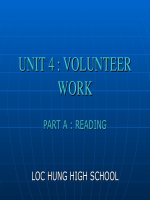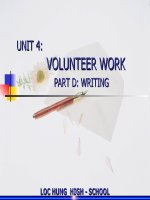Unit 4. Volunteer work
Bạn đang xem bản rút gọn của tài liệu. Xem và tải ngay bản đầy đủ của tài liệu tại đây (93.76 KB, 3 trang )
<span class='text_page_counter'>(1)</span><div class='page_container' data-page=1>
Date of preparation : 23/10/2015 Date of teaching : 26/10/2015
<b> </b>
<b>Unit 4 : Volunteer Work</b>
<b>Period 25 </b>
<b> Speaking </b>
<b>I. Objectives</b>
<i>By the end of the lesson,Ss will be able to talk about different kinds of activities related to volunteer work.</i>
<b>II. Materials</b>
<i>Textbook, pictures, handouts.</i>
<b>III. Anticipated problems</b>
<i>Ss may not have enough vocabulary to talk about the topic, so T should be ready to provide help</i>
<b>IV. Procedure</b>
<b>Time</b> <b>Teacher’s activities</b> <b> Student’s activities </b>
8’
7’
15’
<b>WARM UP</b>
Ask students to look at the picture in their books and answer
two questions:
What are these students doing?
Are they volunteers
?
<b>TASK 1</b>
<b>Instruction: </b><i>You are required to decide which of the</i>
<i>following activities are volunteer works.</i>
- T asks Ss to work in pairs to decide which of the activities in
the book are volunteer works. Ss should also explain why a
certain activity is not volunteer work.
- T calls some Ss to give their answers ands for comments
from other Ss.
- T elicits other volunteer activities from Ss.
<b>Suggested answers:</b>
1.The activities which are not volunteer work: taking part in an
excursion and participating in an English speaking club.
+ Reason: You take part in these activities for yourself, not to
help other people.
2. Some other volunteer activities: taking part in
environmental conservation activities, donating blood,
directing traffic, guiding foreign sports teams around when
they go to Vietnam to compete...
<b>TASK 2</b>
<b>Instruction : </b><i>You are goimg to make conversations based on</i>
<i>the given suggestions.</i>
- Before Ss do the task, T asks them to read the model
conversation onpage 50. Then Ss read the list of volunteer
activities and the exact things related to them.
- T can elicit or explain some words quickly:
War invalid:<i>th¬ng binh</i>
Martyr: <i>liƯt sü</i>
Intersection : <i>đờng giao nhau</i>
- T gets across to Ss that one activity in the first column can go
with several activities in the 2nd<sub> column. T may require Ss to</sub>
Group work
Answer the questions:
They are helping an old man
with the housework.
Yes, they are.
</div>
<span class='text_page_counter'>(2)</span><div class='page_container' data-page=2>
match each activity on the left with corresponding activities on
the right.
<b>Suggested answers:</b>
Helping people in
mountainous areas
- Teaching the children to
read and write
- Give them money
Help old and sick people - Cleaning up their houses
- Doing their shopping
- Cooking meals
Helping disadvantaged or
handicapped children
- Teaching the children to
read and write
- Listening to their problems
- Playing games with them.
- Taking them to places on
interest
Taking care of war invalids
and the families of martyrs
- Listening to their problems
- cleaning up their houses.
- Doing their shopping
- Cooking meals
Taking part in directing the
traffic
- Directing vehicles ar the
intersections
- Helping old people and
young children to cross the
road
- T may design a handout for this activity to help Ss
talk more naturally and to lead to the next task. Ss
may choose one or more activities to talk about , and
they change the role after one activity.
<b>Student A</b>
<i>You want to take part in the</i>
<i>volunteer work your friend</i>
<i>is doing .</i>
<i>Ask him/her all the</i>
<i>information you want to</i>
<i>know.</i>
<i>You can use suggestions</i>
<i>below:</i>
<i>- kind of volunteer work</i>
<i>- exact things to do</i>
<i>- frequency of doing the</i>
<i>work</i>
<i>- length of time spent for the</i>
<i>work</i>
<i>- your friend’s feeling when</i>
<i>doing the work.</i>
<b>Student B</b>
<i>You are participating in a</i>
<i>volunteer work. Answer your</i>
<i>friend’s questions about the</i>
<i>work. </i>
<i>You can use the information</i>
<i>in TASK 2 to answer the</i>
<i>questions.</i>
- After Ss have finished T calls on some pairs to act out their
conversation.
- T elicits feedback from the class and gives final comments.
Whole class & pair work
Do Task 2 in pairs
Take notes
</div>
<span class='text_page_counter'>(3)</span><div class='page_container' data-page=3>
12’ <b>TASK 3</b>
Instruction: Now you work in groups to talk anout a kind of
volunteer work your partner in the previous task do to help
other people.
- Before Ss do the task, T may ask Ss to read through the
example in the book. T encourages Ss to use transition signals
such as <i>also, besides, moreover,</i> etc. to make their talk more
coherent.
- Now Ss work in groups to talk about one activity their
partner takes part in. They may say that: Mai usually takes part
in directing the traffic. She directs vehicles at the intersections.
Besides, she helps old people and young children to cross the
road. She enjoys the work very much because she likes
helping people.
- T goes around to observe and collect typical errors.
- T calls on some Ss to talk about the activity they take part in
- T elicits feedback from the class and gives final comments.
After that, T writes the errors she has corrected on the board to
elicit correction from Ss and offers correction if necessary.
- Work in groups
- Take notes
- Each group gives a short
presentation
3’
<b>WRAPPING UP</b>
- T summarises the main points of the lesson
- T asks Ss to do the EXTRA EXERCISE as homework
</div>
<!--links-->









